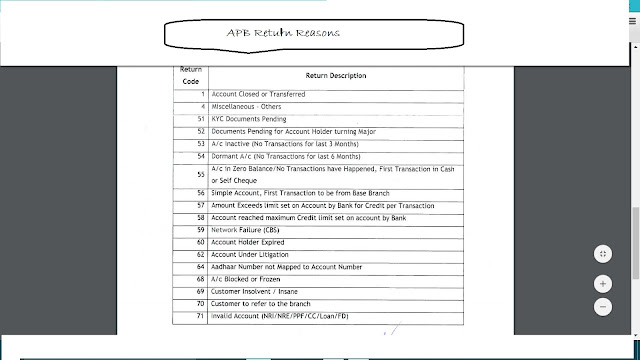Reserve Bank of India announces ‘Cheque Positive Pay’, Go-Live Date
Reserve Bank of India vide Circular No. RBI/2020-21/41 DPSS.CO.RPPD.No.309/04.07.005/2020-21 dt. September 25, 2020 announced the go-live date for ‘Positive Pay System for Cheque Truncation System’.
The
Go-Live date is January 01, 2021.
This
is in line with the ‘Statement on Developmental and Regulatory Policies’ dated
August 6, 2020 wherein Reserve Bank of India (RBI) had announced the introduction
of Positive Pay
System for Cheque Truncation System (CTS).
Q:
What is the concept of Positive Pay for Cheques?
Ans:
The concept of Positive Pay involves a process of reconfirming key
details of large value cheques.
Under
this process, the issuer of the cheque submits electronically, through channels
like SMS, mobile app, internet banking, ATM, etc., certain minimum details of
that cheque (like date, name of the beneficiary/payee, amount, etc.) to the
drawee bank,
The
respective details of are cross-checked with the presented cheque by NPCI CTS
(Cheque Truncation System).
Any discrepancy is flagged by NPCI CTS (Cheque
Truncation System) to the drawee bank and presenting bank, to take the
necessary redressal measures.
Q:
In India, who shall develop the Positive Pay in CTS?
Ans:
3. National Payments Corporation of India (NPCI) shall develop the facility of Positive Pay
in CTS and make it available to participant banks.
RBI
has informed that banks, in turn, shall enable it for all account holders
issuing cheques for amounts of ₹50,000 and above.
While
availing of this facility is at the discretion of the account holder, banks may
consider making it mandatory in case of cheques for amounts of ₹5,00,000 and
above.
Q:
Is there a carrot and stick policy?
Ans:
The RBI Circular clearly mentions that those cheques which are compliant with
above instructions will be accepted under dispute resolution mechanism at the
CTS grids.
Q:
Does RBI mandate Banks to create awareness on the features of Positive Pay
System ?
Ans:
Yes, RBI has advised Banks to create adequate awareness among their customers
on features of Positive Pay System through SMS alerts, display in
branches, ATMs as well as through their website and internet banking.
Brief
details about CTS Grid Dispute Resolution Mechanism
Base
RBI Circulars on Dispute Resolution Mechanism for CTS:
01) RBI Circular dated September 24, 2010 (ref
no. RBI/2010-2011/213 DPSS.CO.CHD.No. 654 / 03.01.03 / 2010-2011)
02) RBI Circular dated September 29, 2010 (ref
No. RBI/2010-2011/218 DPSS.CO.CHD.No.695/ 03.01.03 / 2010-2011).
Quote:
Dispute
Resolution Mechanism
As
per Section 24 (1) of the Payment and Settlement Systems Act, 2007, “The system
provider shall make provision in its rules or regulations for creation of panel
consisting of not less than three system participants other than the system
participants who are parties to the dispute to decide the disputes between
system participants in respect of any matter connected with the operation of
the payment system”.
The
Panel for Resolution of Disputes (PRD) acts as Dispute Resolution Mechanism
(DRM) for resolving clearing related disputes between member banks.
The
“Panel for Resolution of Disputes” (PRD) is chaired by the President of the
Clearing House and consists of a panel of 10 members. In addition to the
members represented in the Standing Committee, additional 4 members are to be
elected in the General Body with due representation of banks in various
sectors.
Cases
of dispute between member banks will be decided by a panel of five members,
including the President. The other four members to be represented in the panel
for deciding the cases will be nominated by the President on a case to case
basis, depending upon the parties to the dispute.
Unquote
Interesting Point:
NPCI
released a concept paper Positive Pay System ‘CPPS: Centralised Positive Pay System’, way
back in September 2015.
The
concept paper was followed by a circular in June 2016.
Concept Paper on
CPSS @ https://www.npci.org.in/sites/default/files/circular/CPPS_Circular_on_Concept_Note.pdf
NPCI 2016 circular
on CPSS @ https://www.npci.org.in/sites/default/files/circular/Centralized_Positive_Pay_system_%28CPPS%29_Specification_for_Banks.pdf
·
SMS
·
Mobile
Banking
·
Net
Banking
·
ATM
The
operating guidelines by banks may be issued in a month or so, to enable their
customers to familiarise themselves with the technical nuances.
The
cheque includes three parties which are as under;
Drawer or maker or Issuer
The
customer or account holder who writes the cheque
Drawee
The
bank on which the cheque is drawn is known a “Drawee”. The cheque is always
drawn on a specified banker.
Payee
The
person who is named in the cheque for receiving payment is called “Payee”. The
drawer and the payee can be the same person.
Under
CPSS, the Issuer of the cheque has to
inform the basic details (as decided in the near future), to the Drawee Bank
i.e his/her bank.
Disclaimer:
RBI Circular is the source data for this post and these are my personal views.
The bottom line is ‘Spreading the Joy of Safe ePayments’.



Comments
Post a Comment